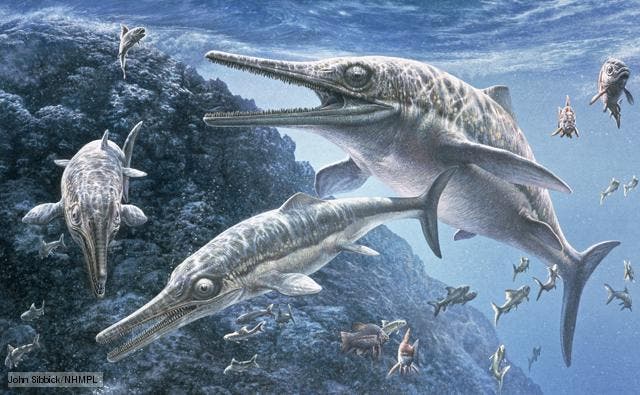During the Mesozoic, dinosaurs weren’t just roaming the land – giant reptiles, such as mosasaurs and ichthyosaurs, ruled the seas. But while scientists have a fairly good idea about how they looked like, until now, they had no idea what colors they featured.

Paleontologists conducted new analysis at the SP Technical Research Institute of Sweden and MAX IV Laboratory, Lund University, Sweden, on fossilized pigment found in skin. They looked at three different samples: a 55 million-year-old leatherback turtle, an 85 million-year-old mosasaur and a 196-190 million-year-old ichthyosaur. This is the first time that the color of any extinct animal has been revealed – let alone animals which lived so long ago. Ichtyosaurs were giant marine reptiles that resembled dolphins in a textbook example of convergent evolution, thriving throughout most of the Mesozoic. As Ichtyosaurs started to decline, Mosasaurs became the dominant marine predators.
“This is fantastic! When I started studying at Lund University in 1993, the film Jurassic Park had just been released, and that was one of the main reasons why I got interested in biology and palaeontology. Then, 20 years ago, it was unthinkable that we would ever find biological remains from animals that have been extinct for many millions of years, but now we are there and I am proud to be a part of it,” said Johan Lindgren about the discovery of the ancient pigment molecules.
Indeed, to find direct evidence of what colors Ichtyosaurs had is simply stunning. For the most part, it was shown that all the samples featured mostly dark colours, which almost certainly contributed to more efficient thermoregulation, as well as providing means for camouflage and protection against harmful UV radiation – to which they were highly sensitive.
When the skeletal remains were found, paleontologists also found dark skin patches containing masses of micrometre-sized, oblate bodies. They were initially thought to be the remains of bacteria which once decomposed the animal, but were later shown to be remnants of the animals’ own colours, and that the micrometre-sized bodies are fossilised melanosomes, or pigment-containing cellular organelles.
“Our results really are amazing. The pigment melanin is almost unbelievably stable. Our discovery enables us to make a journey through time and to revisit these ancient reptiles using their own biomolecules. Now, we can finally use sophisticated molecular and imaging techniques to learn what these animals looked like and how they lived,” said Per Uvdal, one of the co-authors of the study, and who works at the MAX IV Laboratory.

Mosasaurs (which went extinct some 66 million years ago) could reach, in maturity, even 15 meters in length, while Ichtyosaurs averaged 2 to 4 m, but could grow much larger. However, close relatives of the turtle they analyzed still inhabit the Earth today – a testament to their adaptability and resilience.
“The fossil leatherback turtle probably had a similar colour scheme and lifestyle as does Dermochelys [leatherback sea turtle]. Similarly, mosasaurs and ichthyosaurs, which also had worldwide distributions, may have used their darkly coloured skin to heat up quickly between dives,” said Johan Lindgren.
If their interpretations are indeed correct, this raises some interesting questions; most marine creatures living today aren’t black, or even dark. However, the modern deep-diving sperm whale has a similar colour scheme, perhaps as camouflage in a world with little light, or as a means of quick heating with little burn risks.






